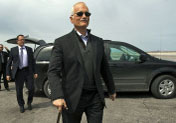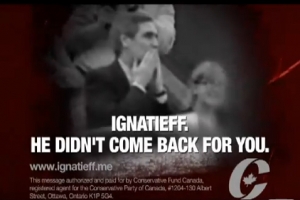Canadian federal election 2011 : Orange Crush .. the plot thickens .. or not?
Apr 29th, 2011 | By Citizen X | Category: In Brief
Daniel (left) and Henrik Sedin are present and past NHL scoring champions. The identical twin brothers were born in Sweden – the land that perfected a kind of common sense social democratic government that, to the surprise of almost everyone, Canada may be taking at least a few further steps towards on Monday, May 2. And best of luck to the Canucks in their struggle against the predatory country music capital too! Photograph by Ian Lindsay, PNG files.
[UPDATED MAY 1, 3]. Assorted fresh intelligence on what Frank Graves at EKOS christened the “Orange Crush” final days of the 2011 Canadian federal election campaign has now surfaced. (Orange is the NDP’s lead colour – as well as, some historians will be amused to recall, the colour of the Orangemen, who were “Canada’s storm troopers of the Tories” in the 19th and earlier 20th centuries.)
Four not entirely consistent opinion surveys probably make the best starting point. The April 28 daily Nanos poll has the Conservatives at 36.6%, New Democrats at 30.4%, Liberals 21.9%, Bloc Quebecois 6% and Greens 4.1%. This is the most favourable of the four for the Conservatives. But even so “pollster Nik Nanos says …Â ‘It would take a phenomenally efficient national Conservative campaign to generate a majority at 36.6 per cent.’”
A new Harris-Decima poll puts the Conservatives at 35%, New Democrats at 30%, and Liberals at 22%. These main numbers are close enough for jazz to the Nanos numbers. But the two polls differ dramatically in their regional numbers for Canada’s most populous province.
On the one hand: “Mr. Nanos points out that the Tories are still comfortably ahead in Ontario – 41.1% support compared to the NDP at 26.1% – but their support has been slipping.” On the other hand, Harris-Decima finds that: “The key battleground of Ontario remains a rare bright spot for the Liberals. Michael Ignatieff’s party led there, supported by 34 per cent of respondents compared with 33 per cent for the Tories and 25 for the NDP.”
These conflicting Ontario numbers only add to the poignancy of such recent musings as Steve Ladurantaye’s Globe and Mail article on “When polls differ, pollsters worry.” (And see too : Brian Bjolin’s comment on our own counterweights editors’ “Is there any chance April 25 EKOS poll is straw in the wind we’ve been waiting for (well some of us anyway)? ; Randall White’s discussion of four earlier opinion polls in “Canadian election 2011 .. now it seems things are starting to get interesting .. maybe (would you believe PM Jack?)” ; the counterweights editors’ early March discussion on “The Canadian federal election of 2011 : was Diefenbaker right about polls?” ; and Alexandre Blanchet’s interesting comment on that article!)
Meanwhile, EKOS’s own April 28 update of its dramatic April 25 numbers puts the Conservatives at 34.8%, New Democrats at 27.5%, Liberals 22.3%, Greens 6.8%, Bloc Quebecois 6.1%, and Other 2.5%. This time, however, the deepest Orange Crush numbers are coming from Forum Research, which has Conservatives 34%, New Democrats 31%, Liberals 22%, Greens 7% and Bloc Quebecois 6%.
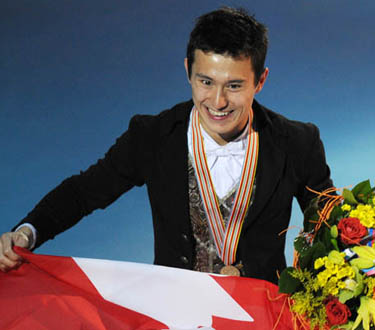
20-year-old Toronto native Patrick Chan waves a Canadian flag after winning the men's event of the ISU World Figure Skating Championships on April 28, 2011 in Moscow. The city Canadians love to hate is not dead yet! Photograph by: YURI KADOBNOV, AFP/Getty Images.
The Forum Research numbers also put the NDP quite awesomely ahead of the Bloc in Quebec (where, as so often happens with Canadian political trends, the Orange Crush began) – 40% to 23%. And all this results in a another stunningly radical set of seat projections for the 41st Parliament in the Canadian House of Commons: Conservatives 137, New Democrats 108, Liberals 60, and a mere 3 seats for the Bloc Quebecois!
The New Democrats and Liberals together on this scenario would have a comfortable enough majority in the House (168 seats where 155 counts as a bare majority), based on some 53% of the Canada-wide popular vote (compared with 137 seats based on 34% of the popular vote for the Harper Conservatives. And all this helps explain such recent screaming headlines as: “Growing NDP support ‘crystallizes’ coalition threat: Harper” ; “Harper warns of devastation and destruction if NDP gains control” ; “Walkom: Layton’s surge could go even further” ; and “Want to welcome Harper? … ‘Let me think about it,’ Tory official says.”
* * * *
At the same time, there remains an on-the-other-hand argument to the Orange Crush theory. And it is summarized nicely in a National Post headline from only a few days ago: “Lorne Gunter: The NDP surge will give Harper his majority.”
(Or, as Mr. Gunter elaborates: “Thanks to vote splitting on the left – the NDP with the Liberals in much of Canada; the NDP with the Bloc in Quebec – the Tories will win a plurality in enough close ridings to take a slim majority of seats.”)
If the latest polls do seem to throw some cold water on arguments of this sort, there are still, oh say, two-and-a-half days left in Campaign 2011. Both the Conservatives and the Liberals are working hard to turn back the NDP surge. It just may run out of enough steam by Monday, May 2 to reinstate some probability of what Nik Nanos was calling the “squeaker of a majority” thesis at the start of this week.
Meanwhile, most seat projection sites on the world wide web remain more conservative (and Conservative) than the latest stunningly radical scenario from Forum Research above (which nonetheless does bear some similarity to what EKOS has been suggesting this week as well).
“Canadian Election Watch”’s April 28 numbers, eg, give the Conservatives 151 seats (four shy of a bare majority but still 8 more than they won in 2008), New Democrats 82 seats, Liberals 46 seats, Bloc Quebecois 18, and Other 1. Canadian Election Watch has also posted an average of eight other seat projections that have appeared on the net over the past two days. And this gives Conservatives 147, New Democrats 73, Liberals 61, Bloc Quebecois 26, and Other 1.
“ThreeHundredEight.com”’s April 28 seat projection puts the Conservatives exactly where they were in 2008 – at 143 seats. And this projection is at least still more small-c conservative in its scepticism about the ultimate on-the-ground impact of the NDP surge: It suggests Liberals in second place with 74 seats, the New Democrats with 47, and the Bloc Quebecois with 43.
Bryan Breguet’s April 28 seat projection at “Too Close to Call” does put the New Democrats in second place (and it gives the Conservatives one less seat than in 2008). But it too remains more small-c conservative than Forum Research or EKOS. It suggests: Conservatives 142, New Democrats 88, Liberals 64, Bloc Quebecois 14.
More anecdotally, Liberal heavyweight (and former Ontario NDP premier) Bob Rae was in Nova Scotia this past Wednesday. And he told the people of Enfield and Dartmouth in greater Halifax that “polls don’t tell the whole story …Â Canadians may be surprised by the result of this election because the Liberal party still has such a powerful ground game … ‘I think there’s a very good case to make that with the strength in organization and the strength on the ground that we have, that it’s going to be a much more interesting House of Commons than some of the published projections that we’ve seen would make you believe,’ he said.”
* * * *
Meanwhile again (the Halifax Chronicle Herald has also reported): “With the party headed for a historic rout, some Liberals are starting to muse about the possibility of merging their party with the NDP. Rae, a one-time NDP premier of Ontario, said it is too soon to discuss that … ‘I think it’s time to have an election and see what happens and then all this other talk is just pure speculation until after May 2,’ he said …”
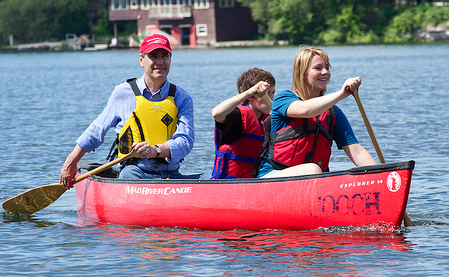
Michael Ignatieff and two young friends, exploring cottage country in the classic Canadian mode of water transportation.
Mr. Rae’s North Atlantic ruminations on his current party’s powerful ground game notwithstanding, there does seem more and more somewhat sad evidence that the once mighty Liberal Party of Canada actually is “ headed for a historic rout” on Monday, May 2, 2011. And already the jokes have begun.
Chantal Hébert’s April 28 column in the Toronto Star ends with: “On the highway to Montreal’s Trudeau airport – one of the rare landmarks of the past Liberal glory in Quebec – there is a big Ignatieff billboard. ‘Quebecers have the power to change things,’ it proclaims … That part of the Liberal message has obviously resonated.”
The Orange Crush of 2011, that is to say, began in Quebec. And if it does prove surprisingly potent on May 2, once again the first people who called themselves Canadians, on the banks of the St. Lawrence, will have successfully led the rest of Canada through the wilderness, if not exactly to the land of milk and honey on the other side. (And I am not myself one to complain about this kind of thing : I think it has finally made Canada a better place in which to live!)
As Ms. Hébert also explained this week on TV, it’s the NDP leader Jack Layton that Quebec has suddenly discovered, and not so much the NDP as an institution. Somehow the francophone masses remembered that, despite his long sojourn in Toronto municipal politics, Jack Layton was born and raised in la belle province. He had a grandfather who served in the cabinet of Maurice Duplessis (who gave Quebec its present national flag), and he speaks the kind of populist French you learn on the streets of Montreal (or something like that).
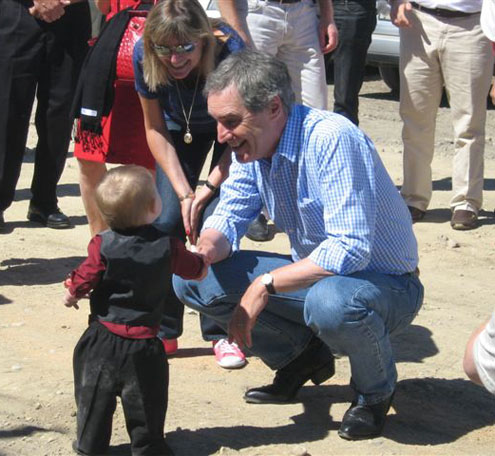
Liberal leader Michael Ignatieff with his wife Suzanna is greeted by one-year-old Cash Andrews on arrival in Vernon, BC, August 24, 2010. Photo: Peter Davidson.
In any event, the federal Liberals may not have much to look forward to on May 2 (maybe, maybe not?). But both Justin Trudeau and Michael Ignatieff are among the four male finalists in Zach Bussey’s “Canada’s Sexiest Election Candidate” contest. Iggy can at least be happy that no other federal party leader, of either sexual orientation, did so well. And some might wonder if there is any significance at all in the complete lack of Conservative candidates in the list of eight male and female finalists.
(The three parties that are represented are the New Democrats, Liberals, and Greens! O and btw: “a Green Party-commissioned poll by Oraclepoll Research Ltd. released Tuesday found that 44.5% of voters in the riding [of Saanich-Gulf Islands in BC] are ‘most likely’ to vote for [Green Party leader Elizabeth] May … That compares with 37.8% per cent for [Conservative incumbent Gary] Lunn, 9.1% for NDP candidate Edith Loring-Kuhanga, and 8.5% for Liberal candidate Renée Hetherington.”)
So … whatever else, it should be quite intriguing (if also a bit nerve-wracking?) to watch the truth revealed at last on TV, on Monday, May 2. And, whatever else, this time we really don’t seem to know the fundamentals of what’s probably going to happen in advance. (Or at least I certainly don’t, and it doesn’t seem to me that anyone else does either.)
UPDATE MAY 3: Well it’s all over today! See the counterweights editors on “A historic unnecessary election .. probably .. and now there’s only one party responsible for the next four years” …
UPDATE MAY 1: See the counterweights editors on “Nothing dead certain about end of surprising and unsettling Canadian federal election campaign of 2011.”

